Happy National Aboriginal Day 2011 Canada .. even if the Ossossane Ossuary in Old Wendake is still not perfect ..
Jun 21st, 2011 | By L. Frank Bunting | Category: In BriefTonight at 9 PM ET (6 PM PT) the CN Tower in Toronto will be lit in the colours of the traditional Medicine Wheel, to help celebrate National Aboriginal Day in Canada, June 21, 2011. The first National Aboriginal Day was celebrated 15 years ago in 1996, when Governor General Romeo LeBlanc declared in Ottawa: “On June 21st, this year and every year, Canada will honour the native peoples who first brought humanity to this great land. And may the first peoples of our past always be full and proud partners in our future.”
This brings us at least somewhat closer to what Canada’s most interesting and certainly near-great historian (and economist), Harold Adams Innis, told us as long ago as 1930, in the intermittently sparkling conclusion to his youthful classic, The Fur Trade in Canada : An Introduction to Canadian Economic History: “We have not yet realized that the Indian and his culture were fundamental to the growth of Canadian institutions.”
It also touches on the more recent wisdom advanced by the legal scholar Brian Slattery, in an Osgoode Hall Law Journal article also first published 15 years ago in 1996. Slattery distinguishes between two “models” of the Canadian Constitution: “The Imperial Model” (old and increasingly out of date) and “The Organic Model” (new in some ways, but even older in others, and the ultimate wave of the future, for anyone who really has their ear to the ground).
In the conclusion to his 1996 article, Slattery writes that “the Organic Model encourages us to broaden our conception of the sources of Canadian law and to recognize the diverse roles that Indian, Inuit, and Métis peoples have played in the formation of this country and its Constitution. It suggests that Aboriginal peoples should be viewed as active participants in generating the basic norms that govern us–not as people on the fringes, helpless victims, or recipients of constitutional handouts from the government or the courts, but as contributors to the evolution of our Constitution and most fundamental laws … The Model represents a further stage in the long process of decolonization that Canada has undergone since 1867. If we have been slow to free ourselves from the trammels of imperial rule, preferring to accomplish by gradual processes of evolution what others have effected abruptly by force of arms, we have been even slower to embark on the task of internal decolonization.”
Nothing in human history is perfect, of course, even or especially in Canada. (I finally reject the Christian doctrine of Original Sin myself, but I do agree that it can at least explain what adult experience confirms as certain inherent flaws in the DNA of our species.) Things are certainly better than they used to be between what the Constitution Act 1982 calls “the aboriginal peoples of Canada” and the rest of us. But we still have a very long way to go in “realizing” the deeper wisdom alluded to by the likes of Brian Slattery and Harold Innis. And, as politically incorrect as it may be to say such things out loud, this applies to both sides of what we, all of us, aboriginal and non-aboriginal alike, still seem to want to conceive of as some great divide.
These last kinds of thoughts came a little too unhappily into my mind last week, during a visit to what a roadside sign calls the “Ossossane Bonepit” in present-day Simcoe County, Ontario (formerly and still sometimes now known as Huronia, and/or even more anciently called “Wendake” – the land of the people, etc). I had last visited the place perhaps as much as 20 years ago, when responsibility for this ancient aboriginal graveyard still lay in the hands of the Royal Ontario Museum. Since 1999 the Huron-Wendat Nation (or more exactly “la nation huronne-wendat”) – headquartered in Quebec, but with “enrolled members” as far away as the State of Virginia – has apparently been responsible for the “Huron Ossuary of Ossossane” in Central Ontario. And it saddens me to report that the site now seems, to a non-aboriginal person such as myself at any rate, a less striking and respectful tribute to the ancient Children of Aataentsic – in the Cradle of Ontario’s History – than it did 20 years ago.
Francis Gros Louis remembers the summer of 1999
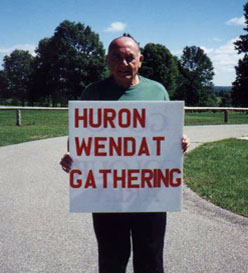
Francis Gros Louis at the 1999 Midland gathering of the Huron Wendat Nation in present-day Simcoe County, Ontario.
The story of how the Huron Ossuary at Ossossane (and some of its ancient remains of the children of Aataentisic) finally passed from the Royal Ontario Museum to the Quebec-headquartered Huron-Wendat Nation in the summer of 1999 is told in “The Reburial of the Human Remains of my 350 Year Old Ancestors” by Francis Gros Louis – who describes himself as “An Enrolled Member of the Huron-Wendat Indian Nation” and also talks about “returning home to my state of Virginia in the United States.”
To summarize Francis Gros Louis’s story quickly: “Historical evidence of the importance Huron people placed in honoring their deceased was recorded by Jean de Brébeuf, a famous Jesuit Missionary who arrived in Huronia in 1626 and later was captured by the Iroquois Confederacy and put to death in 1649 …
“In his brief writings Brebeuf noted of his attendance at a Feast of the Dead and the mass burial of hundreds of Huron-Wendat people at Ossossane in 1636. He marked the site with a crude wooden cross and it was later discovered by archeologists in 1948 leading them to the excavation of over 500 Huron-Wendat human remains and taken to the Royal Ontario Musuem in Toronto, Canada.
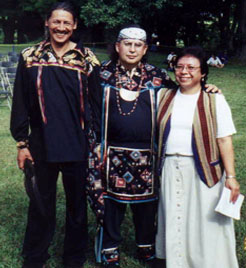
Michel Gros Louis (centre) with two Chippewa friends at the 1999 Midland gathering of the Huron Wendat Nation in present-day Simcoe County, Ontario.
“Although his first request for the return of his ancestor’s remains was denied, Michel Gros Louis [of the Huron-Wendat Nation in Quebec] persisted and working with a dedicated associate, Annette Vincent through the Agondachia Association he finally obtained an agreement with the officials at the Royal Ontario Museum to return the human remains for reburial in 1999. The Agondachia Association is dedicated to the preservation of the Huron-Wendat culture, traditions, and heritage of all Huron-Wendat people.
“The Huron-Wendat Nation Gathering and reburial ceremonies was scheduled for the weekend of August 27-29, 1999, in Midland, Ontario some 350 years after the original burial of their ancestors in the Ossossane Burial Pit. No one can comprehend what compelled so many Huron-Wendat descendants from all over the United States and Canada to attend the reburial ceremonies for their ancestors. For many it was a severe financial hardship and yet they felt an inner power that compelled them to attend. And perhaps no one will ever know what brought about this magnificent moment in Huron-Wendat history 350 years after the original burial and 50 years after they were excavated by archeologists in the name of research.”
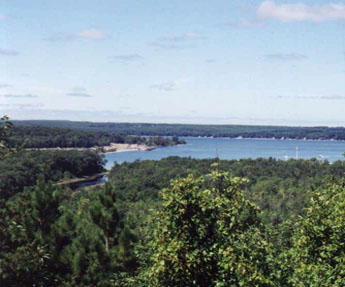
The Wye River at Georgian Bay – a key gateway to old Wendake (aka Huronia), the cradle of Ontario’s modern history.
About a month a half after the reburial ceremonies: “ On October 18, 1999 the Huron-Wendat Nation by vote and the Council of the Huron-Wendat Nation adopted a Resolution accepting the offer of the Royal Ontario Museum to assume responsibility for the sacred burial site at Ossossane. This will ensure the maintenance of this sacred site forever and is the seed through which the Huron-Wendat people of Wendake may one day have a permanent Gathering site in Midland, Ontario, known always by the Huron-Wendat people as Wendake (Huronia).”
What is the future of the Ossossane Ossuary site in 2011?
From what I can make out very quickly on the world wide web, since the summer of 1999 the Ossossane Burial Pit site in Simcoe County, Ontario has been the site of a number of “Annual Wyandot homeland gatherings.”
(The Wyandots are the descendants of the Wendat who were over-aggressively expelled from the region between Lake Simcoe and Georgian Bay in what is now Canada’s most populous province of Ontario in the middle of the 17th century, by the Five Nations Iroquois from what is now upstate New York. Francis Gros Louis describes how at the Ossossane ceremonies in late August 1999: “A large gathering of descendants including tribal leaders from the Huron-Wendat of Wendake [in Quebec], Wyandottes of Oklahoma, Wyandots of Kansas, and Anderdons of Michigan were joined by many curious onlookers as all stood in muffled silence waiting for the arrival of the human remains from the Royal Ontario Museum.”)
Judging again just by what is easiest to find on the world wide web, the most recent Annual Wyandot homeland gathering seems to have taken place July 18—19, 2009. The announcement on the net reads: “The 2009 gathering will be in july 18nd and 19rd … The main events will be on Saturday … Ossossane and the camp site will be available all the week before the gathering … Despite the fact we have now installed a well and have water, be aware that it is a wild camp site still with very few facilities, but there are few good campgrounds near by Ossossane for people who wants to get more facilities … Hope to see you all…”
This “wild camp site” is what you now see when you travel down the short road from the “Ossossane Bonepit” sign in present-day Simcoe County, Ontario. It is what I saw last week. It includes several ramshackle canopies and a few electrical outlets at rough campsites. And it dredges up quite different feelings and reactions than the ancient burial site I first saw on this site some 20 years ago – a somewhat pristine clearing in a modest forest, with a bowl-shaped indentation in the earth with a flat bottom, approximately 24 feet from rim to rim – which once housed a mass of bone said to be about five to six feet deep.
I certainly agree that the bones of Francis (and Michel) Gros Louis’s ancestors of some 350 years ago are more properly re-buried at the Ossosane Ossuary than stored in some research vault at the Royal Ontario Museum. And if someone is going to be responsible for administering the Ossuary site in Central Ontario today, who better than the Huron-Wendat Nation at what is now called Wendake, Quebec – where the most loyal Huron-Wendat allies of the first people who called themselves Canadians fled, in the wake of the dark destruction of Huronia or old Wendake in the middle of the 17th century?
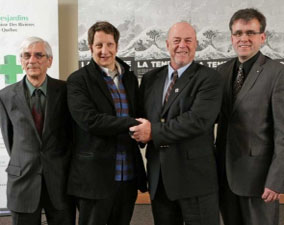
L to R: Michel Gros-Louis, President of the Caisse Desjardins de Wendake, Robert Lepage, Grand Chief Konrad Sioui and Gilbert Guay, Director of the Caisse Desjardins des Riviéres de Québec. Lepage will be staging Shakespeare’s The Tempest in Wendake, Quebec this summer. Photo: Pointcom.
On National Aboriginal Day 2011, however, there may also be some appropriate small place for the observation that we do indeed still have many miles to go before we rest, on the long journey to realizing altogether at last that the Indian and his culture were (and still are) fundamental to the growth of Canadian institutions. And, nowadays, responsibility for continuing progress on this journey rests with the non-aboriginal and aboriginal people of Canada alike. If “charming Wendake, home of the Huron-Wendat nation” in Quebec can serve as a chosen site for Robert Lepage’s “latest production of William Shakespeare’s classic play” The Tempest in the summer of 2011, it ought to be able to do a little bit more than it seems to be doing right now with the Ossosane Ossuary in Central Ontario.
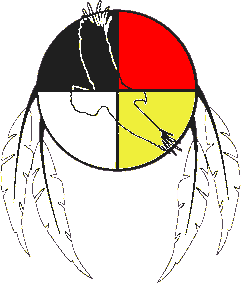
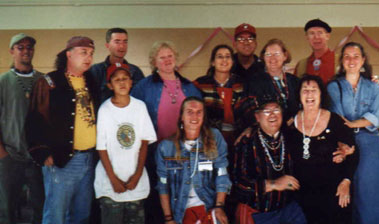
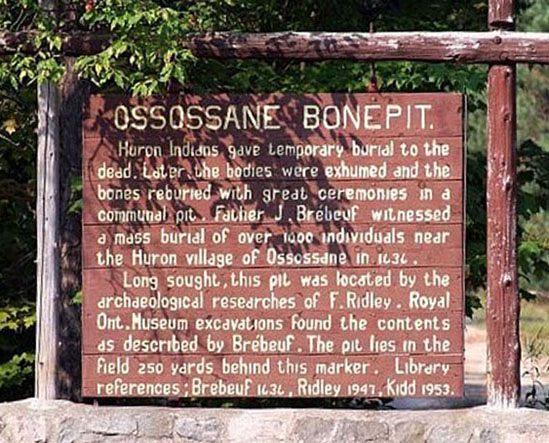
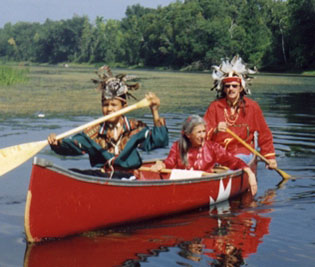
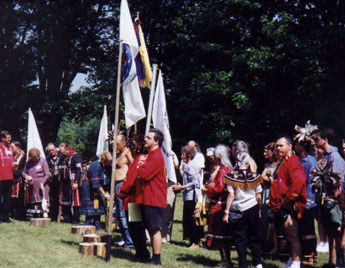
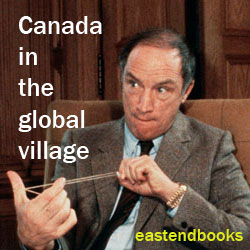
Francis Gros Louis was my first boss at the United States Department of Housing and Urban Development. He was a great person/boss. I will never forget him. He gave me my first chance in the working world. Hey, Francis, I’m retiring in 4 years. I can hardly wait. They are transferring me to Jacksonville, Florida with the transformation initiative, though. I will love it in sunny Florida. I will most likely end up in Orlando, Florida in retirement which is where I want to be.
Hello, My name is Ronnie Burnside.
I am the person in the center of the first group picture listed, and was one of the four men in the burial pit in Ossosane in 1999.
I am looking to contact Michel Gros Louis, and others that were present at that time. It was a life changing experience, and would love to hear from others in my extended family.
email @ tewatia1966@gmail.com
My cook pot was used by Annette in ceremony for the reburial